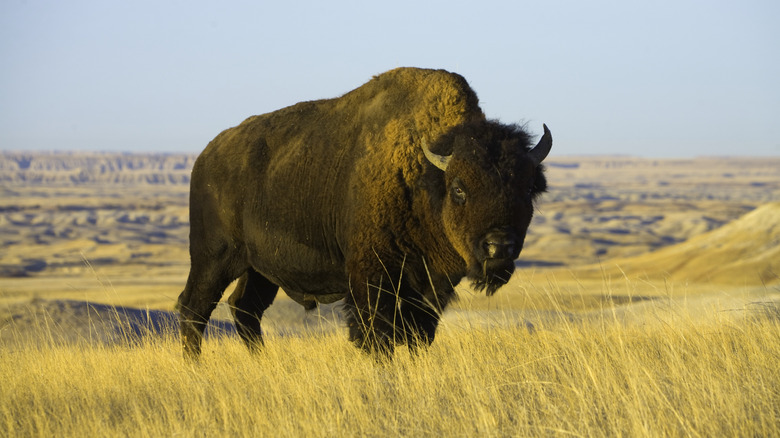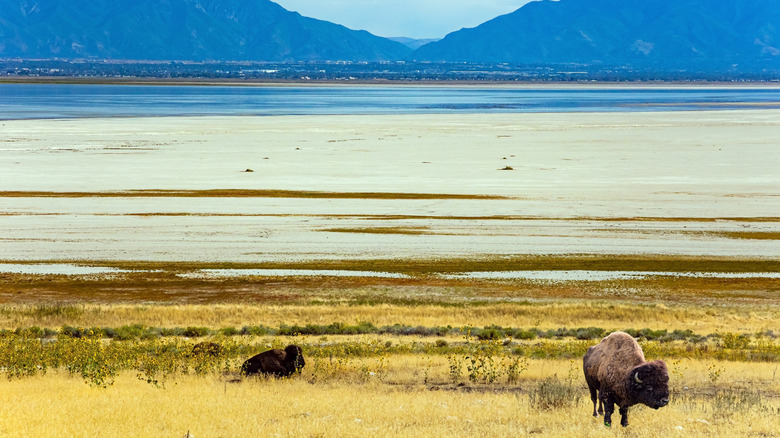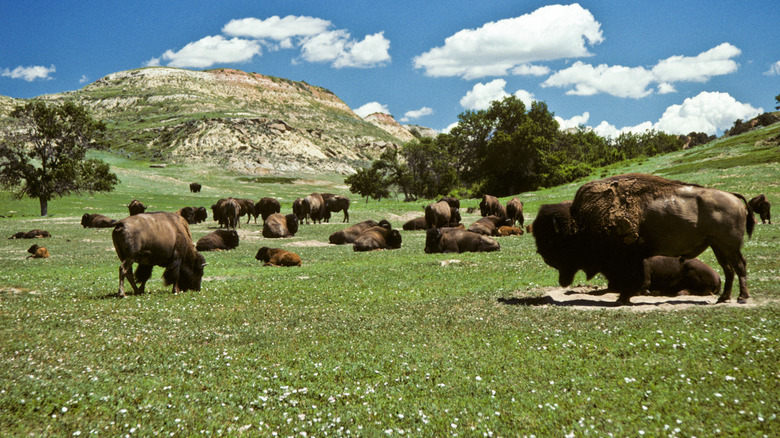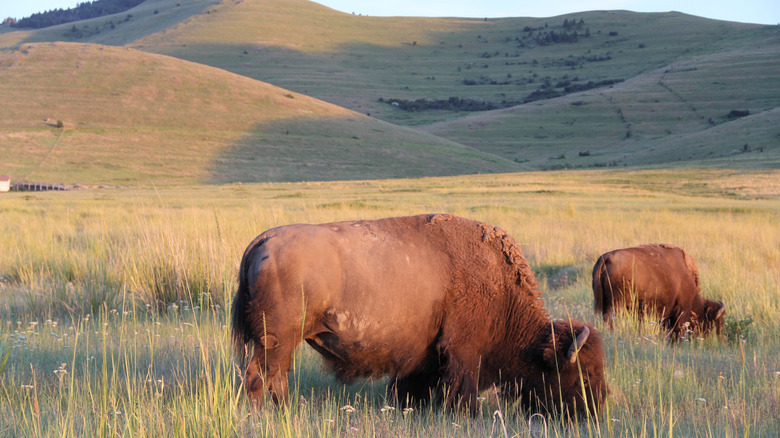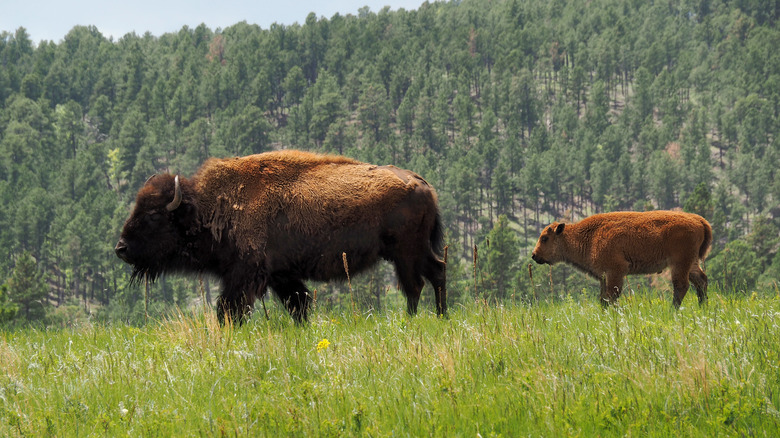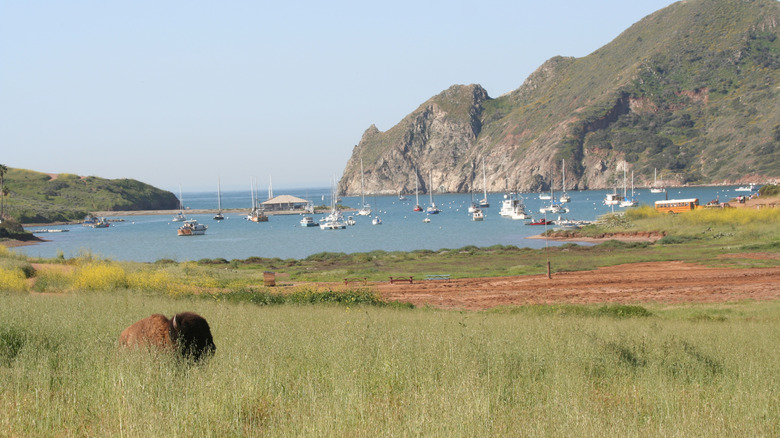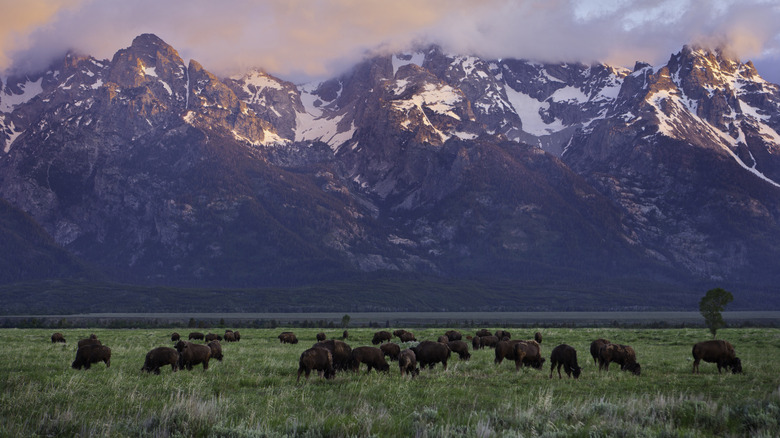The 5 Best Parks Where You Can See Bison Roam (Other Than Yellowstone), According To Visitors
Bison have long been a symbol of the American West, and at one time, there were around 30 to 60 million of these majestic animals living across North America. However, due to overhunting and the purposeful culling of wild herds, only a measly 512 bison were left by 1889. Thanks to conservation efforts, the American bison was not lost to extinction. Today, there are around 20,000 wild bison living in protected herds in national and state parks across America. In fact, one of the most famous places to visit to see these magnificent beasts is Yellowstone National Park, which has two herds with a combined population of around 4,550 animals.
However, as one of the most popular national parks in America, Yellowstone can get pretty crowded with travelers and vehicles during the high season. Luckily, if you want to see bison without the hassle of wading through the Yellowstone crowds, there are plenty of lesser-known national and state parks across the American West that are home to herds of wild bison, as noted by visitors via online platforms like Reddit and Tripadvisor.
When watching these majestic animals, it is also important to remember how big and dangerous they really are. For the safety of you and the bison, always keep a good distance (at least 25 yards) between you and the animals. You should also never walk towards a bison or try to touch one, as doing so can have disastrous consequences and end with you in the hospital. That being said, here are some great parks where you can safely see the awe-inspiring American bison.
Antelope Island State Park, Utah
Antelope Island is a little-known state park in Utah full of incredible beaches and wildlife. It is located in Great Salt Lake, about a 58-mile drive from Salt Lake City. This makes Antelope Island super accessible if you already have a trip to Utah planned and will be stopping in the Beehive State's capital. Plus, this state park is also a great place to see bison, as there are around 500 to 700 bison on the island at all times. Visitors often see them hanging out in fields or crossing main roads in the park. In fact, at Antelope Island, it is hard not to see a bison. One reviewer on Tripadvisor explains, "They're near the road, on the road, near the lake edge, they're everywhere!"
To see the bison, you can explore the island either in your car or on one of the park's many hiking trails. If you want to experience a full western spectacle, you can even visit Antelope Island during the annual bison roundup. Here, horse riders scour the island and round up all the bison into one large herd before leading them into a holding pen where they are given yearly vaccinations and health checkups. The bison that live on Antelope Island are a part of one of the oldest public herds in the country, and state park officials take the care and health of the animals seriously. In order to ensure that the herd does not become too large for the island and negatively affect the ecosystem, some of the bison are removed and sold each year after the annual roundup.
Theodore Roosevelt National Park, North Dakota
Theodore Roosevelt National Park is an uncrowded and underrated gem that is particularly beautiful to view fall foliage. Plus, due to its slightly out-of-the-way location in the Badlands area of North Dakota, this park doesn't receive the visitors it deserves for its incredible array of wildlife and great hiking trails. On top of other large animals like elk, wild horses, and bighorn sheep, this national park also has two bison herds — one in each of the park's distinct units.
The herd in the South Unit is slightly larger, with anywhere between 200 and 400 bison at any given time; the North Unit grouping typically contains 100 to 300 animals. While the South Unit offers more hiking and is generally more popular, according to one commenter on Reddit, "Both units have plenty of bison, it just depends on the time of day you're visiting the park (South Unit you'll see them midday, North Unit you'll see them more in the mornings and evenings)."
No matter which area you choose (or if you decide to visit both), the best way to get the most out of your time in Theodore Roosevelt National Park and see as many bison as possible is to take a scenic drive. The scenic loop in the South Unit takes around two hours to complete, and the North Unit's route takes around an hour and 15 minutes. While the bison are active during all seasons of the year, if you want to see baby bison, you should visit in spring.
National Bison Range, Montana
Home to around 350 bison, the National Bison Range is located in western Montana near the Flathead Reservation. Once managed by the U.S. Fish and Wildlife Services, the ownership of the land was recently returned to the Confederated Salish and Kootenai Tribes (CSKT), to whom the land originally belonged. In fact, the animals that graze in the National Bison Range (also known as the CSKT Bison Range) today descend from the herd started by tribal members in the 19th century to help combat the overhunting and near extinction of the American bison.
If you want to see these beautiful mammals living as they have for thousands of years before colonization under the care and stewardship of Native Americans, there's no better place than the CSKT Bison Range. The best way to explore is by driving through the park down Red Sleep Drive, which is also the access point for the Bitterroot and High Point trails. Red Sleep Drive can also be connected to the Prairie Drive to form a two-hour wildlife viewing loop. Entrance into the park costs $20 per vehicle at the time of this writing.
Custer State Park, South Dakota
Located only around a 15-minute drive from Crazy Horse Memorial and a 45-minute drive from Mount Rushmore, Custer State Park is known as one of the Midwest's most underrated and is an easy addition to any trip to South Dakota. This is especially true if you want to see bison. Custer contains one of the largest publicly-owned herds in the world, with around 1,400 of these magnificent animals. While there are hiking trails in the state park, because the bison are quite spread out, the best way to see them is by driving the Wildlife Loop Scenic Byway. This drive takes around 1.5 to two hours and is worth the trip. One reviewer on Tripadvisor describes, "The wildlife is abundant and with each turn you will see nature at its best. The sights are a photographer's dream."
Like Antelope Island State Park, Custer State Park also has an annual bison roundup. Horse riders come to the park to help corral these beautiful animals into one area for herd management and health checks. The roundup normally takes place on the last Friday in September and is a fun sight to witness. At the same time, there is an art festival in the state park that features live music and hot air balloons.
Catalina Island Conservancy, California
Located just off the coast of Southern California near Los Angeles, Catalina Island is only an hour-long ferry ride away from San Pedro, Long Beach, or Dana Point — making this the perfect stop for anyone who wants to combine the chance to see some wild bison with a relaxing beach vacation on an island often called the American Amalfi Coast. Interestingly enough, although Catalina Island Conservancy Park maintains a herd of bison, these large mammals are not native to the area and were originally brought over to be extras in a movie in the 1920s. When the movie ran out of funds, the crew was unable to ship the original 14 bison back. Since then, the herd has made the island its home and now contains around 150 individuals.
Today, the bison are protected and maintained by the Catalina Island Conservancy, an organization that manages most of the island and offers bison jeep tours to visitors. One reviewer on Tripadvisor notes, "The tour itself was beautiful and we saw bison and a Catalina fox. Our school age children also enjoyed the tour. Highly recommend." Two- and three-hour eco-tours can be booked directly through the Catalina Island Conservancy's website and cost between $100 and $170 per person. On the island, you'll also find special buffalo milk cocktails at multiple bars, along with bison burgers. Bison meat is known for its lean qualities and low environmental impact.
Methodology
To choose the parks included in this article, we researched and compared all the different nature parks in the U.S. that contain herds of wild bison. After scouring articles and traveler reviews, all of the parks mentioned have a reputation for being great places to spot these majestic animals. Highlighting parks and ranges with an emphasis on bison conservation was also an important factor that was taken into consideration.
We prioritized parks that had large and well-managed bison herds but were also generally quiet and uncrowded — something that sets them apart from Yellowstone National Park. This also makes for a better chance of capturing incredible photos. In searching through reviews of these parks, we prioritized areas where visitors could easily find and see at least a few bison while walking or driving. While some of these parks are in the same state, we also tried to choose preserves that covered different areas of the Western U.S.
